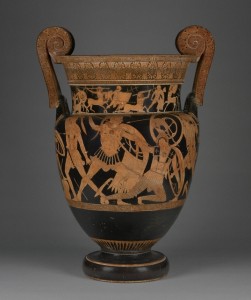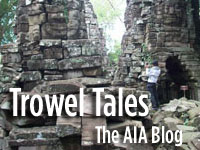A Positive Note from the Getty
by Mark Rose
June 9, 2010
I received a press release a few days ago announcing that the Getty Museum was now displaying a 5th-century B.C. krater, a vessel used for mixing wine and water, on loan from the Agrigento regional museum in Sicily. If you’ve followed the “antiquities wars†closely over the past years, you’ll understand the importance of this. If not, you may recall Italy’s efforts to reclaim artifacts from U.S. museums and private collections. Essentially, Italian authorities had a huge amount of confiscated documents (see Geneva Seizure and Raiding the Tomb Raiders) giving them the evidence to argue these artifacts were stolen property. As a result, the Metropolitan, Museum of Fine Arts (Boston), Getty, and others have either returned antiquities or now face long legal–and PR–battles.

Excavated in 1889 at Gela, Sicily, the krater shows a battle between Greeks and Amazons, centering on a fight between a Greek hero, possibly Achilles or Theseus, and an Amazon. (Attic red-figured volute krater, about 475 - 425 B.C., attributed to the Niobid Painter. Museo archeologico regionale Agrigento, Agrigento, Italy, AG 8952)
In negotiating the returns, the museums and Italy agreed on paper to put as good a face on things as possible. Not wanting to appear vindictive, the Italians offered to loan the American institutions important artifacts for display. This approach follows the spirit of an agreement between the United States and Italy. In 2003, Archaeological Institute of America president Jane C. Waldbaum, wrote in ARCHAEOLOGY, explaining the agreement’s parameters, which specify “significant programs of legal cultural exchange, including long-term loans of archaeological materials for research and exhibition and a framework for scholarly and scientific cooperation between the countries†and defines a wide range of Italian archaeological materials the importation of which to the U.S. is now closely governed. (You can read Jane Walbaum’s 2003 column here, and see the U.S. State Department website about cultural heritage in general and the agreement with Italy in detail.)
What caught my eye was the tone of the Getty’s press release. Italy has loaned objects to other museums under similar circumstances. But in some cases, the recipient museum has downplayed the loan, displaying the artifact off to one side in a gallery and doing little to interest the press or public in it. But here, the tone is all positive:
The J. Paul Getty Museum has announced the installation of the Gela Krater at the J. Paul Getty Museum at the Getty Villa as part of a long-term collaborative agreement between the Getty Museum and the Sicilian Ministry of Culture and Sicilian Identity.
And everyone is either genuinely happy about the outcome, or at least putting on a brave face:
Acting Getty Museum director David Bomford commented, “One goal of our agreement with Sicily is to share our knowledge with our Sicilian colleagues and, in partnership with them, work to preserve Italy’s rich cultural heritage.” Adds Dr. Giuseppe Castellana, the director of the Museo Archeologico in Agrigento, “I am hopeful that this first collaboration is only the beginning of a long-lasting friendship between our two institutions and will pave the way for a number of additional projects.”
Obviously, press releases are meant to highlight things, promote events, and generally cast all in as good a light as possible. Is everything as neat and tidy it is presented in this press release? I doubt it. But I do appreciate that the Getty is publicizing the display of this artifact—and a marble statue of a youth ca. 480 B.C. from the Agrigento museum, which goes on display in the fall (plus there are cooperative agreements with the Naples and Florence archaeological museums). It’s great, too, that Italy is following through on these cooperative projects, which include not just exhibitions but object conservation, scholarly research, and conferences.
Bottom line is, as Jane Waldbaum suggested years ago, we all win here: the Getty gets amazing artifacts to display, Italy shares it cultural heritage in a way that does not mean sites have been looted, and you and I get to see these ancient works. That’s not bad.
Comments posted here do not represent the views or policies of the Archaeological Institute of America.






 Heather Pringle is a freelance science journalist who has been writing about archaeology for more than 20 years. She is the author of Master Plan: Himmler's Scholars and the Holocaust and The Mummy Congress: Science, Obsession, and the Everlasting Dead. For more about Heather, see our
Heather Pringle is a freelance science journalist who has been writing about archaeology for more than 20 years. She is the author of Master Plan: Himmler's Scholars and the Holocaust and The Mummy Congress: Science, Obsession, and the Everlasting Dead. For more about Heather, see our 

